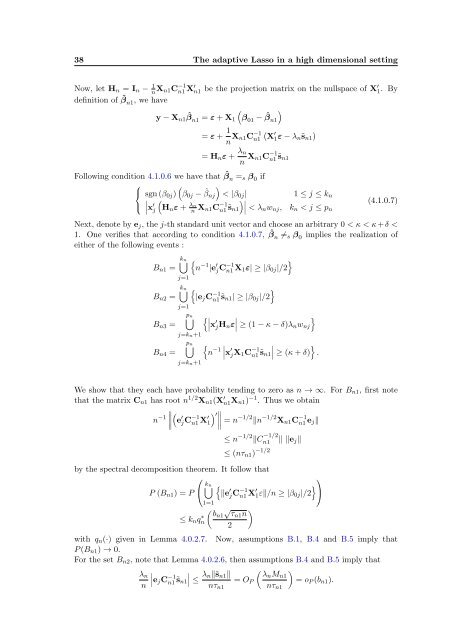Subsampling estimates of the Lasso distribution.
Subsampling estimates of the Lasso distribution.
Subsampling estimates of the Lasso distribution.
You also want an ePaper? Increase the reach of your titles
YUMPU automatically turns print PDFs into web optimized ePapers that Google loves.
38 The adaptive <strong>Lasso</strong> in a high dimensional setting<br />
Now, let H n = I n − 1 n X n1C −1<br />
n1 X′ n1 be <strong>the</strong> projection matrix on <strong>the</strong> nullspace <strong>of</strong> X′ 1 . By<br />
definition <strong>of</strong> ˆβ n1 , we have<br />
(<br />
y − X n1 ˆβn1 = ε + X 1 β 01 − ˆβ<br />
)<br />
n1<br />
= ε + 1 n X n1C −1 (<br />
n1 X<br />
′ )<br />
1 ε − λ n˜s n1<br />
= H n ε + λ n<br />
n X n1C −1<br />
n1 ˜s n1<br />
Following condition 4.1.0.6 we have that ˆβ n = s β 0 if<br />
⎧<br />
⎨ sgn (β 0j )<br />
(β 0j − ˆβ<br />
)<br />
nj < |β 0j | 1 ≤ j ≤ k n<br />
(<br />
)∣<br />
⎩ ∣<br />
∣x ′ j H n ε + λn n X n1C −1<br />
n1 ˜s ∣∣ (4.1.0.7)<br />
n1 < λn w nj , k n < j ≤ p n<br />
Next, denote by e j , <strong>the</strong> j-th standard unit vector and choose an arbitrary 0 < κ < κ + δ <<br />
1. One verifies that according to condition 4.1.0.7, ˆβn ≠ s β 0 implies <strong>the</strong> realization <strong>of</strong><br />
ei<strong>the</strong>r <strong>of</strong> <strong>the</strong> following events :<br />
B n1 =<br />
B n2 =<br />
B n3 =<br />
B n4 =<br />
k n ⋃<br />
j=1<br />
k n ⋃<br />
j=1<br />
⋃p n<br />
j=k n+1<br />
⋃p n<br />
j=k n+1<br />
{<br />
}<br />
n −1 |e ′ jC −1<br />
n1 X 1ε| ≥ |β 0j |/2<br />
{<br />
}<br />
|e j C −1<br />
n1 ˜s n1| ≥ |β 0j |/2<br />
{∣ ∣∣x ′<br />
j H n ε∣<br />
∣ ≥ (1 − κ − δ)λ n w nj<br />
}<br />
{<br />
n −1 ∣ ∣ ∣x<br />
′<br />
j X 1 C −1<br />
n1 ˜s ∣<br />
n1<br />
}<br />
∣ ≥ (κ + δ) .<br />
We show that <strong>the</strong>y each have probability tending to zero as n → ∞. For B n1 , first note<br />
that <strong>the</strong> matrix C n1 has root n 1/2 X n1 (X ′ n1 X n1) −1 . Thus we obtain<br />
∥ ∥∥∥ ( ) ∥<br />
n −1 e ′ jCn1 −1 ′ ∥∥∥ X′ 1 = n −1/2 ‖n −1/2 X n1 C −1<br />
n1 e j‖<br />
≤ n −1/2 ‖C −1/2<br />
n1 ‖ ‖e j ‖<br />
≤ (nτ n1 ) −1/2<br />
by <strong>the</strong> spectral decomposition <strong>the</strong>orem. It follow that<br />
⎛<br />
⋃k n {<br />
} ⎞<br />
P (B n1 ) = P ⎝ ‖e ′ jC −1<br />
n1 X′ 1ε‖/n ≥ |β 0j |/2 ⎠<br />
≤ k n q ∗ n<br />
1=1<br />
( √ ) bn1 τn1 n<br />
2<br />
with q n (·) given in Lemma 4.0.2.7. Now, assumptions B.1, B.4 and B.5 imply that<br />
P (B n1 ) → 0.<br />
For <strong>the</strong> set B n2 , note that Lemma 4.0.2.6, <strong>the</strong>n assumptions B.4 and B.5 imply that<br />
λ n ∣<br />
∣e j C −1<br />
n1<br />
n ˜s n1∣ ≤ λ ( )<br />
n‖˜s n1 ‖ λn M n1<br />
= O P = o P (b n1 ).<br />
nτ n1<br />
nτ n1
















